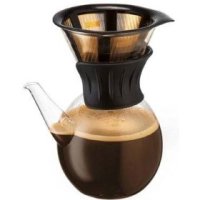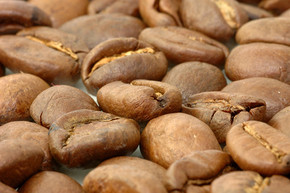How do you drink filter coffee?
Follow the caf é (Wechat official account vdailycom) and found that Beautiful Cafe opened a small shop of its own.
Prepare the tool:
Filter cup + filter paper + hand punch + cup with capacity scale
Filter cup
Filter pot
Filter paper: this hat of the little friend is coffee filter paper.
The steadily injected water column dances with the coffee powder in an elegant swing to extract the pure coffee flavor. Filter coffee seems simple, but it still needs more practice to fully master the water injection skills, which is the most direct interaction between people, water and coffee beans.
The brewing type of filter paper is filtered by filter paper or filter cloth, so there is no coffee grounds in the coffee. The filter paper not only filters the coffee powder, but also hinders the passing of coffee oil, so it tastes much cleaner and refreshing than the French filter press. The most commonly used brewing method in Japanese cafes is the brewing of filter paper.

Filter type is just a general term, which can be divided into three types according to the different filter materials:
1 flannel: cloth filter material, the flow rate is the fastest, but cleaning and maintenance is more troublesome, it is not enough to use clean water after each use, it must be boiled in hot water to ensure its cleanliness, and a new flannel filter must be replaced after use for a period of time.
2 filter paper: paper filter material, medium flow rate, filter paper thrown away after use, no need to worry about cleaning and maintenance. There are two kinds of filter paper: bleaching treatment and unbleaching treatment, the former is white, the latter is khaki, there is no difference in use.
3 metal filter: numerous small holes are punched on the extremely thin metal sheet as the filtering material, and the flow rate is the slowest of the three materials. Because there is no need for filter paper or filter cloth, there is no part that will wear out and can be used indefinitely. In addition, the cleaning liquid is very easy and can be rinsed with clean water after use, which is quite environmentally friendly.
Here we can see that because of the different filter materials, the flow rate of coffee is also different, so the brewing skills should pay attention to adjust the soaking time according to the flow rate.
In the filter type must be used in the hand pot, there are many types of hand pot on the market, imported or domestic quality are good, of course, the texture is mostly proportional to the price. The key point of the selection of the hand punch is that the spout should be as long as possible and the pipe diameter should be small, because the effluent will be more stable in this way. If the center of gravity is taken into account, the connection between the mouth pot and the kettle body should be as close to the bottom of the pot as possible, which is easier for friends who are just starting to use it.
In particular, it is recommended to brew one person at a time. If you want to brew multi-person coffee, it is necessary to increase the amount of coffee powder. The increase in the amount of coffee powder will lengthen the soaking time, together with grinding thickness and water injection speed. Everything has to be adjusted together, so before you are proficient, brewing one cup at a time is the best way to control the quality of coffee.
Filter paper cooking method:
1 fold the bottom and side of the filter paper from the front and back respectively along the binding edge
After the 80% discount, put the filter paper flat into the filter cup and press it slightly to the bottom of the filter cup.
3 grind the coffee beans, pour some hot water into the filter cup while the coffee machine is running, wet the filter paper and warm the cup at the same time
Pour out the warm cup water first, and then pour the ground coffee powder into the filter paper
5 use a small spoon or finger to dig a hole in the middle of the coffee powder. The diameter of the hole is about 1 / 2 of the round diameter covered by the coffee powder, while the depth is slightly lighter than the diameter.
6 inject a small amount of steady hot water from the middle of the pothole and circle it clockwise, stopping when it comes to the edge of the coffee powder
7 stand for 30 seconds (this process is called steaming) if the coffee beans are fresh, you will see the coffee powder expanding slightly; otherwise, you will see the whole coffee powder collapsing in the middle.
8 after the end of steaming, water injection again, this time the water injection method is the same as step 6, the water output should also be stable and uninterrupted, the difference is to go around to the edge and then go back to the center, so that the back and forth cycle 3-4 times can stop water injection. When the coffee reaches a sufficient amount, remove the filter cup immediately and complete the whole brewing action.
Water injection mode
Go out clockwise and come back counterclockwise
Go out clockwise and come back clockwise
Tips for flushing and cooking
1 the main points of using hand flushing pot
The water output should be stable and continuous, and do not suddenly increase or decrease or cut off the water, let alone use a very large water column to make coffee. The skill of injecting water must be practiced many times before it can be skillful. At the same time, you should always keep this sentence in mind.
2 it is best to prepare a thermometer to measure the water temperature of cooking. Try to keep the water temperature between 90-95 degrees for lightly baked beans and 85-90 degrees for deep-baked beans. Different beans and different baking depths have suitable temperatures. Just try it a few more times.
3 you might as well try to circle more, you can go in one direction from beginning to end, or you can go out clockwise and counterclockwise when you come back. In addition, the frequency and duration of steaming can also try to make some changes.
(4) the purpose of steaming is to lengthen the soaking time, so that the flavor of coffee beans can be extracted more completely, which is to comply with the characteristics of fast flow rate and short soaking time. So the times and time of steaming can be adjusted according to the thickness of coffee beans. If the whole process of water injection can be uninterrupted, at the same time very stably lengthen the injection time, you can also try not to use steaming.
5 the amount of water injected can be a little more than the predetermined amount, for example, when you want to flush out 200CC coffee, you can inject 250CC water, on the one hand, the coffee powder will absorb part of the water, on the other hand, keeping a certain amount of water in the filter cup can keep the whole brewing process at a consistent flow rate because of sufficient water pressure above, so as to prevent the last part of the water from staying in the coffee powder for too long.
Important Notice :
前街咖啡 FrontStreet Coffee has moved to new addredd:
FrontStreet Coffee Address: 315,Donghua East Road,GuangZhou
Tel:020 38364473
- Prev
How to make coffee foam
Following Jiabei (Wechat official account vdailycom) found that Beautiful Cafe opened a small shop of its own. Milk is also food before making milk foam, it is important to remember that milk can not be made again after beating. For example, we fried eggs. We don't put fried eggs in the fridge and then take them out and then fry them again. Because an egg is a protein mass. The situation with milk is similar. Cattle
- Next

Why is some coffee sour?
Following caf é comments (Wechat official account vdailycom) found that coffee acidity is affected by coffee raw beans themselves. Coffee acidity is affected by the quality of coffee raw beans. In terms of variety, the original Arabica is sour than the original Robusta, while in terms of elevation, the coffee grown in the highland is sour than that in the lowland.
Related
- Beginners will see the "Coffee pull flower" guide!
- What is the difference between ice blog purified milk and ordinary milk coffee?
- Why is the Philippines the largest producer of crops in Liberia?
- For coffee extraction, should the fine powder be retained?
- How does extracted espresso fill pressed powder? How much strength does it take to press the powder?
- How to make jasmine cold extract coffee? Is the jasmine + latte good?
- Will this little toy really make the coffee taste better? How does Lily Drip affect coffee extraction?
- Will the action of slapping the filter cup also affect coffee extraction?
- What's the difference between powder-to-water ratio and powder-to-liquid ratio?
- What is the Ethiopian local species? What does it have to do with Heirloom native species?

